The Creation of a Human Being From a Cell
The Transformation Begins: The Three Stages of the Baby in the Womb
 |
| They do not render to God the homage due to Him. Yet God is Powerful and Almighty. |
As is obvious from what has been said so far, in the period of time between the formation of the sperm and the egg and their meeting, every event that occurs is a miracle. The changes that occur after these two cells unite, and the all-encompassing preparations made in the woman's body will show us other wondrous occurrences.
Even within hours of the time when it is fertilised by the sperm, the egg divides and grows very quickly. Today we know that the baby undergoes three stages of embryonic development while it is in the mother's womb. But this information, which it has taken long years of research to attain with the help of modern technology, was made known in the Qur'an 1400 years ago. These scientific facts are revealed in this verse:
... He creates you stage by stage in your mothers' wombs in a threefold darkness. That is God, your Lord. Sovereignty is His. There is no god but Him. So what has made you turn away from Him? (Qur'an, 39: 6)
It will be noticed that this verse shows that three distinct stages occur in the development of a human being while it is in the mother's womb. Indeed, modern biology has established that the baby in the mother's womb does go through three different stages of development, just as is stated in this verse. This is a matter of basic information in all the books on embryology required to be read as textbooks today in medical faculties. For example, Basic Human Embryology, a standard basic work of reference on embryology, makes the following statement:
The life in the uterus has three stages: (i) pre-embryonic: first two and a half weeks; (ii) embryonic: until the end of the eighth week, and (iii) fetal: from the eighth week to labour.
These stages comprise the various developmental phases of the baby. The salient features of these three stages can be summarized as follows:
- Pre-embryonic stage: In this first stage the zygote (the newly fertilised cell) multiplies. Within the first three weeks, after it has become a cluster of cells, it embeds itself in the wall of the uterus. As the cells continue to multiply, they form three layers.
- The embryonic stage: The second stage lasts a total of five and a half weeks, during which the baby is called the embryo. In this stage the basic organs and systems of the body take shape from the cell layers.
- The foetal stage: Entering the third stage of pregnancy, the embryo is now called the foetus. This stage begins from the eighth week of pregnancy and continues to birth. In this stage, as distinct from the earlier ones, the face, hands and feet of the foetus become distinguishable and it takes the external appearance of a human being. At the beginning of this stage, all the organs of the 3 cm. foetus are in place. This stage lasts for thirty weeks and development continues until the week of birth.
The stages that we have briefly outlined here and the wondrous developments that happen in each stage will be explained in more detail in the pages that follow.
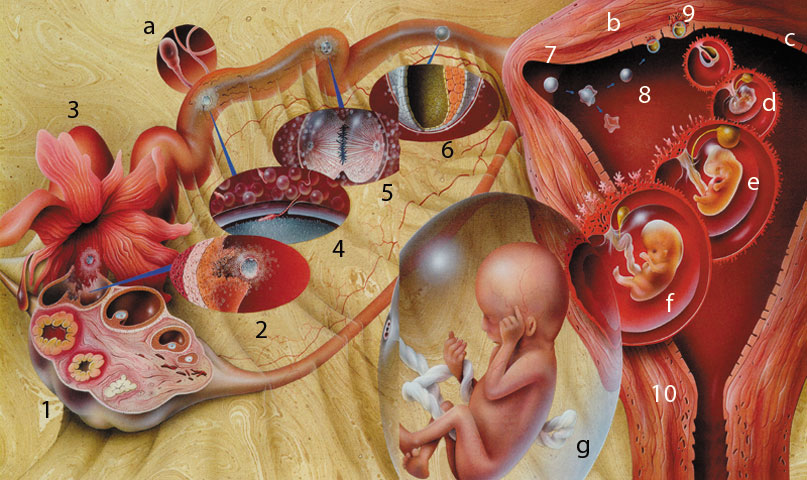 | ||
| 1. Developmental Phases of The Egg | 7. Fertilized Cell Cluster Enters The Uterus | a. Sperm cell |
| 1) Every month an egg is released from the ovaries. | ||
The First Cell Begins to Multiply
The cell containing 46 chromosomes that is formed from the union of the sperm and the egg is the first cell of a new human being that will open its eyes to the world in nine months. The first and single cell which contains the plan for the whole body is called the "zygote".
The first cell division happens 24 hours after the sperm and the egg unite. These two newly formed cells are identical to each other. With this, the first day of the 9-month period of life in the mother's womb begins. Now there are not one but two cells in the mother's womb. Later this number will increase to four and continue in this way as the division multiplies.22
The cells in the cell cluster in the fallopian tube continue to divide and grow and move towards the place where they will spend the next nine months. This is the mother's womb (uterus).
In this stage, the necessary changes occur in the uterus. Blood rushes into the uterus and makes it strong and resilient. As we mentioned in the previous section, the corpus luteum in the ovary increases its secretion and informs the body that pregnancy has begun. In the meantime, the zygote moves with a swimming motion towards the uterus and begins to send a biochemical signal containing the message, "I'm here!" These messages make the mother's body prepared to ensure the presence of the salt, iron, blood and vitamins needed by the foetus. At the same time, the biochemical message that the zygote has secreted (the hCG hormone), reaches the mother's ovary and causes another hormone to be secreted there which prevents another period of ovulation (menstrual period) in the mother's body.23
 |
| After uniting with the sperm, the egg cell begins to divide. In the first division 2 cells are formed; these two cells divide internally and within a short time a cluster of cells is formed. As a result of the transformations undergone by this cluster, the vital structures of the baby are formed. After the period the baby spends in its mother's womb, it is ready in every way for life in the outside world. |
 |
| The heart, nerves, spine, arteries, lungs, teeth, bones, taste-buds—all these vital parts are formed while the embryo goes through the stages in the mother's womb. For example, at the end of the third month, the sex of the baby has been determined. The parts of the brain have been formed. At the end of the eighth month, virtually all parts of the baby's body have been formed. |
The zygote is still composed of a few cells. The fact that it knows where it is and immediately sends signals relevant to the 9-month period that will follow is an extraordinary thing. How does the zygote know to whom it will send the message? How do the various organelles that receive the message know that it comes from a microscopic piece of flesh that they have never encountered before, and begin to help it by preparing an environment in which it will live? After all, the hormone secreted by the zygote is composed of molecules; so, how do the cells, in the place where these molecules are received, know what these molecules intend by arriving at that place? When a message is sent to a human being in a language that he understands, it is possible for him to read and understand it, and to make a decision on the basis of what he has understood. But in this case, the message consists of a hormone composed of a few molecules; what sends the message is a collection of cells; what receives the message is a slightly larger collection of cells. It is certainly a miracle that cells read and understand messages (hormones) that come to them just as a human being understands a message he reads.
Moreover, how does this zygote know what materials it will need in the course of its growth?
For example, think of yourself. What do you need to eat in order for your body to become strong? What minerals do you need to take? You can only learn this by studying scientific work that has been done in this area. What effects do potassium, phosphorus and calcium have on your body? From what food can you get these things? When should you take this food and how much should you take? These are things that you cannot know without consulting an expert. You, as a thinking, seeing, intelligent and feeling person, with the faculty of speech, can only know these things by seeking assistance; whereas a minute cluster of cells knows what it needs, and that it is necessary to produce it if that need is to be met; it knows who can produce what is necessary and that a signal must be sent to begin the process of production. Moreover, in spite of the fact that it has been in the body for only a few days, it knows how to send chemical information and it calculates that various organs in the body are capable of receiving this chemical information.
Certainly it cannot be said that a cluster of cells has this extraordinary information and devises a plan on the basis of it. There is a supreme power which makes these cells perform all their wondrous functions and creates them in a way that enables them to do their work. This power belongs to God, the only Ruler of the heavens and the earth. As a proof to us of His eternal power, God has inspired microscopic, unconscious, living cells, in a way that the human mind could never comprehend, to perform their complex work to perfection.
The Cell Cluster Begins to Move
 |
| The outer appearance of a mass of cells formed by cell division is like a piece of flesh. |
The cell cluster moves towards the secure place prepared for it and continues to divide from day to day. Every 30 hours a division takes place. Dividing exponentially by 2, 4, 8, 16, etc., the cells gradually come to form a small cluster; moving together with unsuccessful sperm cells, it goes slowly from the fallopian tube towards the uterus.
If you magnify the fallopian tube and examine what happens in it, you will see what appears to be the bottom of the ocean. This cluster of cells can continue on its way because of the undulating movement in the fallopian tube. This movement, which had assured the fertilisation of the egg by pushing the sperm towards it, this time carries the egg to the uterus. Small hairs (cilia) found on the surface of the cells of the fallopian tube move in the same direction. In this way, they carry the egg cell as if carrying a very precious object, towards the place where it must go.
Here, as if all the elements involved in this function have received a command from a common centre, they begin at once to work towards the same goal. This command is such that very different areas of the body perceive it and carry it out. While it is in the fallopian tube, the cluster of cells goes through a number of stages of division. A cluster of about 100 cells enters the uterus. But in order to effect this division, the cells must be nourished. This requirement can be regarded as an important aspect of the miracle of human creation.
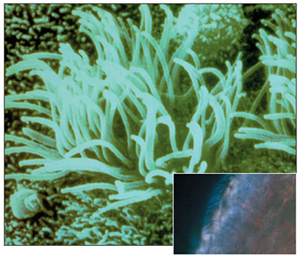 |
| When we look at the motion in the fallopian tube, we get the impression that we are looking at the bottom of the ocean. (small picture) The tiny hairs in the fallopian tube (above) make an undulating motion, which helps the egg move towards the uterus. |
God has created the fallopian tube so as to respond to the needs of the zygote. In this waiting period, secretory cells alternate with the small hair-like cells lining the fallopian tube. The secretory cells produce large quantities of secretions including organic molecules, ions and water for the nutrition of the zygote.24
"…the uterus increases in size to protect the embryo. The fallopian tubes do what is necessary to nourish the cells…" In sentences like these we have spoken up to this point about the tissues and organs that protect the cell cluster that formed after the egg and the sperm united, take the appropriate measures to ensure its nourishment and work to accommodate these cells. It must not be forgotten that these organs and tissues are also composed of cells. So, how can it be that one cell can sense the need of another and, at exactly the right time, undergo the changes required to nourish and protect it?
When we consider this question, the first answer that comes to mind will be that there is an intelligence that controls the cells. No one will think of a fairy tale in which "one day the cells begin to undergo a change by chance and that afterwards these cells somehow become able to produce the nourishment required by the zygote, then go on to sustain these wondrous occurrences that happen in all women." It is clear that anyone who makes this claim will be accused of fabrication. The preparations that the uterus makes to accommodate the embryo and the particular characteristics of the fallopian tubes which allow them to provide nourishment for the zygote, are operations which exist only in the knowledge of God. Each one of these things is a manifestation of the compassion and mercy that God has for every living thing in His perfect creation.
| Uterus: A Safe Haven Created for the Embryo | ||
 |  The uterus is a hollow, muscular organ that weighs about 50 grams. Certainly this is not big enough for a baby to develop in. Therefore, the structure of the uterus must undergo a transformation. During pregnancy, the size of the uterus grows steadily, increasing to about 1,100 grams by the end of pregnancy. Because of this characteristic, the uterus attains the most suitable condition for the growth and development of the fertilised egg and for the emergence of a completely formed human being. Besides this, being exactly in the centre of the mother's pelvic cavity, it shelters the baby and protects it in the course of its development.25 In the Qur'an, God reveals the protective quality of the mother's womb and reminds us once again of His compassion for humanity: We created man from the purest kind of clay; then placed him, a living gem, in a secure receptacle. (Qur'an, 23: 12-13)
| |
| 1. Chorionic villi | 5. Umbilical cord | |
The Cell Cluster Attaches to the Uterus
| Say: "Am I to desire any but God as my Lord, when He is the Lord of all things?" What each self earns is for itself alone. No burden-bearer can bear another's burden. In the end you will all return to your Lord, and He will resolve for you your disputes. |  |
| An embryo burrowed into the lining of the uterus. |
In order for the pregnancy to continue in a healthy way, the cell cluster must find an appropriate place to lodge. A place must be chosen that affords protection and that has the characteristics that will be able to facilitate the birth nine months later. Moreover, this place must also be close to the mother's blood vessels which will provide nourishment for the baby. The most suitable place for this operation is the wall of the uterus.
The cell cluster, which advances towards the uterus from the fallopian tube, moves with an awareness of what it is doing. It is in the fallopian tube for 3-4 days but does not attempt to stop and lodge at any point there. It knows that before it reaches the uterus, no place where it attaches itself will receive it or allow it to survive. It advances towards the uterus; it finds in the walls of the uterus a place where the blood vessels are plentiful and lodges there. As a seed planted in the ground sprouts and spreads its root, so the cell cluster continues to grow, and moving deeper into the tissues that will nourish it, produces for itself new channels for that nourishment.
Here it is useful to notice an important point. It is a wonder that the cell cluster is able to choose the most appropriate place for itself. In his book, Beginning Life, G. Flanagan also asks "How does the cluster make such an astonishingly "forward-looking" selection?"26
The point to which Flanagan draws attention is very important. In order to illustrate this importance, let us first consider an example. Imagine a baby that is just beginning to walk. You place this baby in a building which is millions of times larger than itself, and which it has never seen before; then you expect that the baby can find a room in this building with the most suitable environment for itself. Could a small baby do such a thing? Certainly it could not. If this feat is impossible for a baby which has not yet reached the age where it can use its mental abilities, with no experience or accumulation of knowledge, how much more impossible is it for a piece of flesh, a few centimetres in size, wandering in the dark void of a body, to find the most suitable, most comfortable and most secure place for itself?
Moreover, this cell cluster is not even a human being yet. Remember that what we refer to here is a piece of flesh composed of at the most a few hundred cells (for the moment), with no ears, eyes, brain, hands or arms. But this cell mass, demonstrating an exceptional recognition ability, lodges itself in the uterus as the most suitable place for itself.
The wonders of human creation do not stop here. In every stage of the formation of a human being, there is a wonderful chain of miraculous occurrences. We have spoken about how the fertilised egg cell multiplies and how it finds the place needed for its development. But at this stage, another question confronts us: This cell cluster, composed of cells totally similar to one another, has no special anchor or other similar organ to allow it to attach itself to a place. How then can it attach itself to the wall of the uterus?
 | (A) External View, About 5 Days After Fertilization (B) Internal View, About 6 Days After Fertilization (C) Internal View, About 7 Days After Fertilization (D) Photomicrograph
1. Uterine Cavity |
| With the help of the fallopian tube, a collection of cells (blastocyst) reaches the uterus and lodges there. It is a round body without a hook or any other attaching mechanism and it is a miracle of creation that it is able to attach itself to the uterus. What allows the embryo to manage to do this is an enzyme secreted by cells in its outer layer (trophoblasts). | |
The way the cell cluster attaches itself to the wall of the uterus is part of an interesting and highly complex system. The cells in the outer layer of the cell cluster secrete an enzyme called hyaluronidase. The particularity of this enzyme (as we mentioned before in the case of the sperm) is to break down the acid layer (hyaluronic acid) in the tissues of the wall of the uterus. This enables the cells which form the cell cluster to dissolve the uterine tissue and enter the uterus. Some cells in the cell cluster dissolve the cells of the uterus, penetrate deeper into it and embed themselves securely in the wall.
As we said earlier, the fact that a cell mass can find the place most suited to itself and determine that it is necessary to attach itself to that place is really an amazing thing. By its behaviour, this tiny collection of cells shows the ability to calculate its needs and to act according to this calculation. Yet, it is even more amazing that it knows how to make this attachment and that a few cells have the special ability to achieve it. It is certainly not possible that these cells, by using their intelligence and its will, analyse the hyaluronic acid on the wall of the uterus and begin the secretion of the hyaluronidase enzyme which will dissolve it.
As we explained earlier, unless a person has had special training in chemistry, he cannot give an explanation for this. However, a few cells have this chemical information and use it to perform their vital function in producing what is required to sustain their existence. Moreover, this extraordinary function is performed, not by a single cell alone, but by the cells that have formed every human being, past and present, that has ever existed.
As can be seen in what we have said on this point, in the formation of the cell cluster which will later form the embryo and in the changes undergone by the cells which shelter it, there is a definite and conscious plan. At exactly the right time, the cells which compose the fallopian tube undergo a change and, at a precise moment, the cells which surround the outer surface of the cell cluster begin to secrete an enzyme (hyaluronidase). This conscious plan shows that these functions that occur in the human body are controlled by a superior intelligence.
It is He Who forms you in the womb however He wills. There is no god but Him, the Almighty, the All-Wise. (Qur'an, 3: 6)
| The Attachment of the Embryo to the Uterus is a Miracle of the Qur'an | |
| When we examine the verses in the Qur'an that deal with the attachment of the embryo to the uterus, we see one of the greatest wonders of the Qur'an. In the Qur'an, while referring to the embryo's attachment to the uterus and the beginning of its development, God uses the word "alaq": Recite in the Name of your Lord Who created man from alaq. Recite: And your Lord is the Most Generous. (Qur'an, 96: 1-3) The word "alaq" in Arabic means "something that clings, a leech-like substance". |  |
| In the first picture, we see a one-week-old cell cluster looking for a place in the uterus. After finding a suitable place, the cell cluster dissolves the tissue of the uterine wall and embeds itself in it. (2-3) The embryo securely attaches itself to the uterine wall and begins to take from it the oxygen and other nutrients that it needs. (4) | |
| The Qur'an came down to us 1400 years ago and the fact that God uses this word to describe the development of the embryo in the mother's womb is one if its wonders. The fact that this knowledge, which could not have been discovered by the science of that period, was revealed centuries ago in the Qur'an confirms once again that it is a revelation from God, the Lord of all the worlds. | |
Cells That Perform Various Functions
 |
Do they make things into partner-gods which cannot create anything and are themselves created; which are not capable of helping them and cannot even help themselves? |
| The appearance of the fertilised egg cell on the eighth day. |
On the eighth day, the cells begin to differentiate and they arrange themselves into two distinct groupings, an inner and an outer one. The inner cell mass (embryoblast), forms the cells that the embryo will possess throughout its whole life. The outer group of cells (trophoblast), is composed of the cells that assist the human being in its life in the mother's womb, that is, for nine months until its birth.
The inner cell mass separates itself from the outer group of cells that will serve it throughout the nine months. The remaining region will become the umbilical cord providing the connection between the embryo and the placenta that will develop later. At about the same time that the placenta begins to form, the inner cell mass flattens and develops into three layers of cells in what is called the "embryonic disc".
 |
| From stem cells come all the approximately 200 kinds of cells in the human body. (1) Identical stem cells suddenly begin to differentiate from other cells. With this differentiation, the tissues of the body are formed from stem cells. Fat cells which provide energy (2), cells which heal wounds (3) and blood vessel cells (4) are a few of these tissues. |
The three types of cell layers are the ectoderm, the mesoderm, and the endoderm. In a process called differentiation, cells from each layer move to certain areas of the embryonic disc and then fold over to form tubes or clusters. These tubes and clusters develop into various tissues and organs of the body.27
Cells from the outermost layer, the ectoderm, form the brain, spinal cord, the sense organs and the lens of the eye. Moreover, this layer will form the epidermis, the sweat glands, tooth enamel, hair and nails. The innermost layer of the embryo (the endoderm) will cause the development of the organs that compose the digestive and respiratory systems (liver, lungs, pancreas, etc.) and the related glands (thyroid, thymus, etc.). The third layer (the mesoderm) is formed between these two layers. From this layer are formed the heart, muscles, bones, tendons, kidneys, glands, blood vessels, and reproductive organs. The lymphatic vessels and the epithelia (surface, or lining, tissues) which cover the most internal and external surfaces of the body and its organs also develop from this layer. The cells which compose all the tissues of the body are formed from these stem cells which develop from one of these layers.
It is very important to think about the meaning of the last sentence of the above paragraph, and to consider well the significance of what it says, because only in this way can we begin to conceive of the extraordinary development of a human being. The fact that all the elements that constitute the human body (organs, tissues, systems, blood vessels, blood, etc.) develop from the three kinds of layers that make up the embryo will lead a thinking person to find the answer to the question: Where does this supreme intelligence that the cells possess come from?
In the meantime, there are some details that we must not lose sight of and that make these changes even more extraordinary. For example, in the course of the development of a human being, there is a perfect harmony among these three layers of cells. In order for the approximately 200 kinds of cells in the body to be produced from three kinds of cells, a definite sequence and timing is required. For example, the sequence of events in the differentiation of the blood cells and the skin cells is very different in each case. This is a remarkable phenomenon which raises a number of questions.
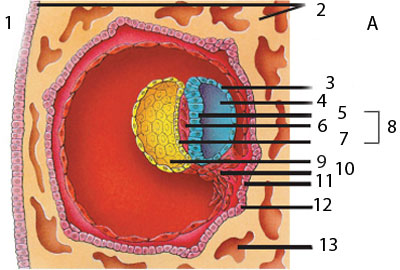 | 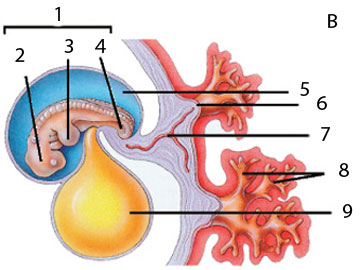 | ||
| (A) Internal View, About 14 Days After Fertilization 1. Uterine Cavity
| 6. Mesoderm | (B) External View, About 25 Days After Fertilisation 1. Embryo
| 5. Amniotic Cavity |
| Changes in the uterus begin with fertilisation and it becomes a place where the baby will spend nine months in security and comfort. The uterus increases in size and provides a protective shelter for the embryo. All the preparations are made by cells in the uterus. There is only one explanation for the fact that these cells are aware of what another cell needs, that is, these cells move according to the inspiration of Almighty God. | |||
The Planned Activity of Cells which Gives Shape to The Body: How Does It Happen?
Now the cluster of cells has become an embryo, which means to "teem within." If we could watch the cells during this period, we would encounter much activity. Cells similar to one another divide and multiply at a certain time and some of these cells begin to take on a different structure from the others. This process is not evident at first, but with every passing day, it becomes clear that the purpose of this activity is to bring into being, quickly and according to a program, the functions indispensable for the construction of the human body. All the cells, very much like workers dispatched to a job, go to work in groups. Later, the groups of cells which are to form the same organ join one another to form one mass and prepare to form the organs. As a result of this intense activity, some cells will become bone cells, while others will become skin and muscle cells.28
The bone cells gather at the places where the bones must be. The muscle cells congregate at the places where the muscles must be. Some cells go to even deeper places and begin to form the internal organs. Some form the brain, some the eyes and others the blood vessels. In time, new processes are added; for example, the movement of the cells to their destined places and the construction of some organs by the programmed death of certain cells, etc. In short, in the course of this differentiation, a perfect strategy is employed in which the cells perform their activity according to a definite plan.
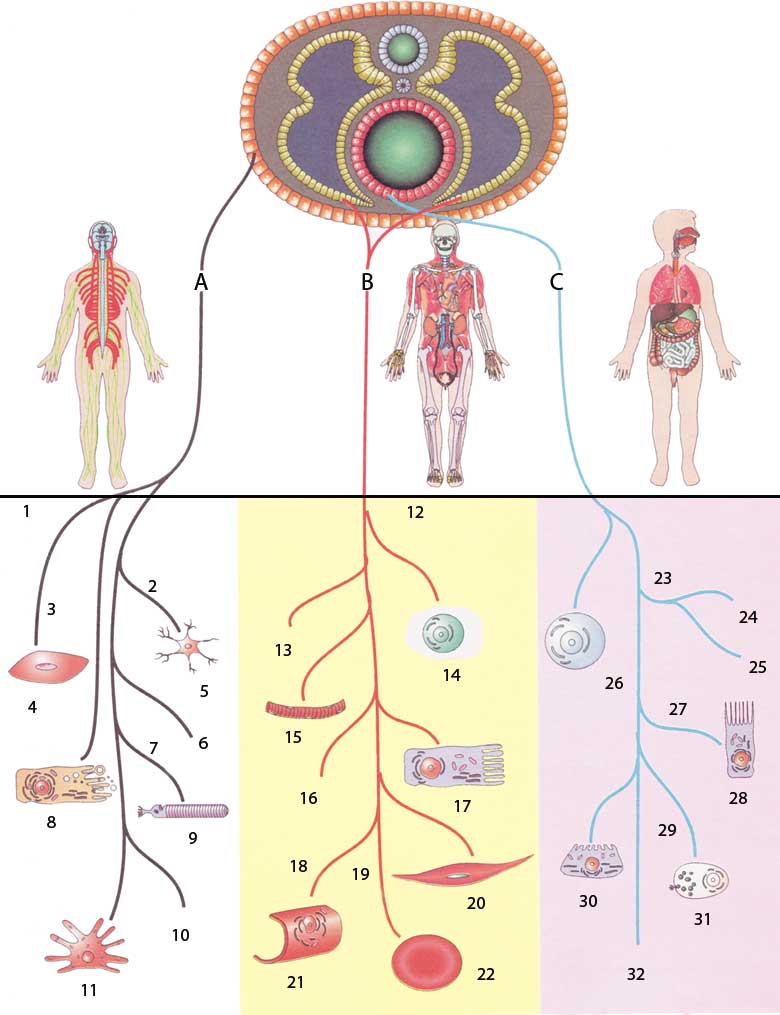 | ||
| A. Ectoderm 1. Epidermis | B. Mesoderm 12. Cartilage Connective Tissue | C. Endoderm 23. Pharynx |
| In the first stages of birth, the cells make exact copies of themselves. If this multiplication were not controlled, a human being would not be formed; rather, a large piece of flesh composed of identical cells would be the result. But such is not the case. Identical stem cells later begin to differentiate. As a result of this differentiation, bones, smooth muscles, epithelium, the liver, the lungs, in short, all the body's cells and tissues are formed. Surely it is the knowledge and incomparable power of God which brings these wondrous transformations in the cells to pass, and ensures the presence of those special elements that make a person a person. | ||
The inspiration as to how this preparation is to be made is introduced separately into every group of cells. The information written in the DNA of every cell is the same. But only when every cell group uses this information in the program which has been placed within the ambit of its own instinct, can they form the special structures needed for the organs to perform their functions. Besides this kind of differentiation, constant division causes their numbers to increase. This perfect organization never falls into anarchy. Because of these preparations made for the formation of the heart, eye, brain, arm, leg and other organs, the body slowly takes shape.29
So far so good, but who gives the command to these cells which all arise out of one single essence? How can cells, which have no intelligence, awareness or feeling, understand this command and put it into effect?
Scientists have determined that the plan which dictates the differentiation of the cells and their lodging in the appropriate place in the body is written in the DNA. But this raises the question: Who wrote this magnificent plan so perfectly in this microscopic information bank hidden in the nucleus of cells?
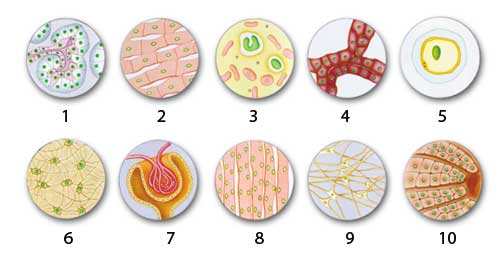 | |
| 1. Pancreas Cell | 6. Bone Cell |
| Above we see a few of the various cells of the body. As a result of the multiplication of the initially identical cells, the approximately 200 kinds of cells in the body are formed. Despite the fact that the information written in their DNA is the same, every kind of cell uses only the information appropriate to itself. No confusion arises. Bone cells never try to form an eye or any other organ; the nerve cells do not interfere with the red blood cells. Each one knows very well where and how it will function. It is Almighty God, the Ruler of all, Who ensures this flawless organization and inspires the cells of the body as to what they have to do. | |
Furthermore, who causes the cells to read this plan written in the DNA and to apply it without error? How is it that millions of different cells can find the information relevant to themselves in an immense information bank in the DNA and change their structure according to it?
For example, consider the cells which form the eyes: How can they know when the pupil is fully formed? How can they know how to structure the retina, the eye muscles, and the lens and how to give them their appropriate size? And how do they know at what point to stop these processes?
Or, how do cells which have never seen a liver, kidneys or a pancreas know the particularities of these organs and change their structure in accordance with this knowledge?
Moreover, when these cells change their structure according to the organs that they are going to form, they take many factors into consideration. For example, a cell which changes to become a brain cell must take account of the nervous system, the nourishment of the brain, the oxygen supply, the necessity of establishing a connection among all the nerves in the body; it must also distinguish the parts of the brain that see, hear and feel. Other cells take into consideration the possibility that the brain might be damaged and surround it; they evaluate the negative factors that could occur in the birth process and form structure according to these considerations. This is all very well, but how can cells display such "prescience" in their behaviour?
It is God Who created the seven heavens and of the earth the same number, His Command descending through all of them, so that you might know that God has power over all things and that God encompasses all things in His knowledge. (Qur'an, 65: 12)
All these questions show that human birth is a great miracle, and the theory of evolution has at this point reached an impasse. No evolutionist can explain the extraordinary cooperation that occurs among the genes in the DNA as the cells form the organs and give shape to the body. The fact that genes, which we may define as a collection of unconscious atoms, cannot organize by chance such a conscious harmony is so evident that evolutionists generally prefer not to broach this subject at all. Hoimar von Ditfurth, A German evolutionist scientist, has this to say about the miraculous development that happens in the mother's womb:
How a single egg cell divides to form so numerous differentiated cells, and the perfect natural communication and the cooperation between these cells top the events that amaze scientists.30
And G. Flanagan, the author of Beginning Life writes:
How is such far-reaching organization achieved? What makes the cells act as if they know where to go, and what to be, and what to do when they get there? And also act in such harmony with their fellow cells?31
In the answer he has tried to give to these questions, Flanagan is far from being able to explain these wondrous occurrences.
These big questions take us into the world of the almost infinitesimally small molecules within the cells, primarily those that compose the genes and make up the genetic programme. Since the advent of molecular biology, it is for the first time becoming possible to detect and describe some of these processes. "Life's book, it seemed, was suddenly laid open…", although only some fascinating pages of it. We are still far from understanding the whole story.
These events may be visualized as an exacting building task requiring close co-operation. Each knows the grand plan, each gives out signals, and in turn sensitively responds to the signals from others to become integrated into the whole project. The cells of the embryo work in a comparable way, in companionable agreement, with genes switched on and off as required.32
It is clear that cells work together so well because there is a continual molecular dialogue between them and they adapt their intrinsic genetic instructions accordingly. The instructions are held in the genes in the form of the so-called genetic-code, spelled out in the arrangement of molecules, like letters of a special alphabet. The genetic programme for the baby, spelled out in that code, was achieved on the first day in the union of parent cells. From then on, every time any cell divided and gave rise to two new cells, a precise replica of all the genes was made and passed along to each new cell. Therefore every cell of the body carries exactly the same genes, and holds the full genetic programme.
Every cell might simply go on to produce clones of itself, all with the same destination and function, if the full programme were to be active all the time. What makes for the great variety of cells produced, and for their dispersal to all their different destinations, is the fact that genes can switch on and switch off. Not all of them are operative all the time. This happens in response to signals from fellow cells as they all fit themselves into the elaborate programme of development.
As can be understood from the above explanations, the fact that the cells differentiate from one another and take on completely different functions is said to indicate that there is a "genetic program" which causes them to act within a determined plan. It is true that a perfect program is implanted in every cell, but the important thing is this: Who created this program and implanted it in the cells? The program we speak of here is not like an ordinary computer program. By applying this program, the cells bring into being a human person who has within himself millions of interrelated complex organic structures: a person who can hear, see, feel, think, make decisions, experience joy, appreciate beauty and who can study his own cells and DNA, and draw conclusions from his investigations. Moreover, it is certainly a miracle that the masses of protein which we call cells can understand such a program, act according to it, become aware of what is required and complete every stage perfectly.
| Cells Shape the Body … | |
|
The stages in the formation of a human being constitute a chain of wonders. Cells uniting according to a certain order give shape to the body. They construct the hands, the eyes, the ears, the blood vessels, the legs, the heart, the brain and the nerve cells. In the DNA of every cell is contained an enormous amount of information relative to every detail of the human body. But the cells in the embryo find and read among all this information only that which pertains to their particular organ. According to this information, cells build the organs and the tissues. How a cell can interpret the information in the DNA is certainly something worth thinking about. Who wrote the information contained in the DNA in the nucleus of the cell? Who programmed cells so that they can read this information just like a human being and act according to it? There is only one answer to this question: God created human beings perfectly. It is He Who inspires in cells what they are to do. | 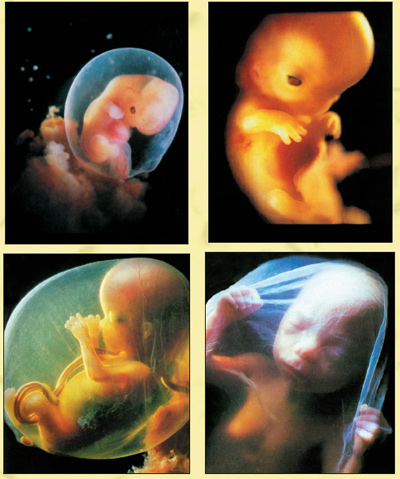 |
Richard Dawkins, a well-known modern evolutionist, is at a loss to explain how, in the formation of a human being, the genes which contain the human genetic program act together with such a degree of cooperation.
Embryonic development is controlled by an interlocking web of relationships so complex that we had best not contemplate it.33
Dawkins has understood that the relations among the genes responsible for the miraculous creation of a human being and the extraordinary abilities demonstrated by these genes could not have come about by chance, that it is not possible to account for such a complex system by the mechanisms of evolution, and has thus made such a confession. But he still misses a very important point: In the same way, it is impossible that, in the chain of miracles that produces a baby, not one bit of what is required to make this baby, not one single cell, has come into being by chance. Within a period of nine months, one cell formed in the mother's reproductive organs turns into a seeing, hearing, feeling, breathing, thinking human being, and this transformation occurs according to a plan perfect in its every detail. Moreover, this miracle has gone on continuously with the same perfection for countless numbers of years.
According to the claims of evolutionists, this is all due to chance; for them, this miracle comes about as a result of the decision of unconscious atoms which produce the human cells. They claim that one day, the atoms suddenly decide to come together and produce organs that they had never seen or known before. They cling so blindly to their illogical claims that they believe that each of these unconscious atoms decides which part it will form and goes to the appropriate places according to this decision. They believe that everything happens as a work of chance without intervention; that the cells and the atoms determine by their own wills the best action to take, and perfectly construct a human body. Even if they do not want to accept what is being said here, this is exactly the substance of what they claim.
At this point it is clear in what an enormous logical impasse evolutionists find themselves. Every detail that has been explained up to now and in what will be dealt with later shows that, contrary to the evolutionists' claims, the stages that occur in the formation of a human being cannot have happened by chance. These extraordinary occurrences happened not by the work of cells or the organelles that brought them into being; not by the activity of molecules or atoms, but by the word of Almighty God, "Be":
It is He Who created you from earth, then from a drop of sperm, then from an alaq (embryo), then He brings you infants into the world; you reach manhood, then you decline into old age though some of you may die young so that you may reach a predetermined age and so that hopefully you will grow in wisdom. It is He Who ordains life and death. When He decides on something, He need only say: "Be!" and it is. (Qur'an, 40: 67-68)
| Awareness Demonstrated by the Egg Cell | ||
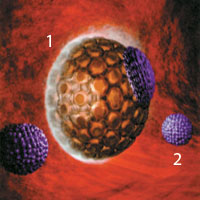 | 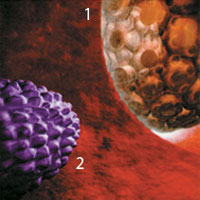 | Attention must be drawn here to a very important point. As Flanagan says, it is a very great mystery how a group of cells sends a "universal message" to another group of cells which receives this message and "understands" that they are meeting not an enemy but a friend. It must be remembered that we are not talking here about a group of human beings, but a mass made up of cells too small to be seen with the naked eye; a mass which has no hands, eyes, ears or brain, composed of unconscious atoms, molecules and proteins. Surely to expect such a demonstration of awareness from cells is extremely illogical. The truth confronting us is clear: What ensures that the embryo lodges easily in the mother's womb and survives there is the mercy of God, Who created the embryo, the mother and the mother's defensive system. Truly, God has knowledge of the Hour and sends down abundant rain and knows what is in the womb. And no soul knows what it will earn tomorrow and no soul knows in what land it will die. God is All-Knowing, All-Aware. (Qur'an, 31: 34) |
| 1. Egg cell The cells which make preparations to lodge in the walls of the uterus are genetically different from those of the mother. Why they are not rejected like an organ or a tissue transplanted to the mother's body has been for a long time an unsolved mystery. R. Flanagan explains it this way: | ||
| The cells which make preparations to lodge in the walls of the uterus are genetically different from those of the mother. Why they are not rejected like an organ or a tissue transplanted to the mother's body has been for a long time an unsolved mystery. R. Flanagan explains it this way:
| ||
The Special Protective System Prepared For the Embryo
The cells which attach to the mother's uterus continue to develop and be nourished in this secure place. But this is an amazing thing, because the quickly growing embryo is normally confronted by a serious danger—the mother's immune system.
The immune system regards every kind of foreign material entering the body as an enemy and attacks it. The embryo's genetic make-up is different from that of the mother and, for her body, it is a foreign organism. The moment the mother's defensive cells become aware of the presence of this foreign organism, they rush towards the uterus. If no special precautions were taken, the defensive cells would surely kill the embryo.
But there is no such occurrence under healthy conditions, because the embryo is taken from the beginning under special protection.
Before the embryo attaches itself to the wall of the uterus, trophoblast cells begin to form around the surface of the embryo, forming a kind of filter between the mother's blood vessels and the embryo. The mother's immune cells are unable to detect the trophoblastic tissues because they lack some proteins that most other cells carry and which help the immune cells to detect them. Thanks to this characteristic of trophoblast cells, the embryo is protected from assault by the maternal immune system. Moreover, some of the trophoblast cells assist in causing oxygen, nutrients and other necessary substances to reach the embryo.
Now, let's examine in detail the special structure of these cells.
The Engineering Ability of the Trophoblast Cells
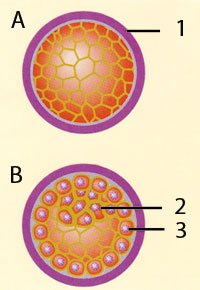 | A. Blastocyst, External View (5 Days) 1. Zona Pellucida Trophoblast cells separate from all the other cells which form the embryo. They are a group of cells which support the embryo in every detail of its development in the mother's uterus. Because of the balance that these cells establish between the mother and the embryo, the development continues safely. For example, these cells prevent pressure on the embryo from the mother's blood vessels or elements of the mother's protective system from damaging the baby. It is surely God Who ensures that these cells are aware of what the baby needs. |
As we explained in the previous pages, despite the fact that the trophoblast cells have multiplied from the same egg cell, they separate from the cells which form the embryo; they are a group of cells that perform all the supportive activities relative to the embryo's development in the mother's womb. On the seventh day, these cells send out projections in every direction and begin to grow. The purpose of this change is to penetrate into the wall of the uterus. During this passage, they meet the mother's blood vessels and penetrate their outer surface. So, within 7-8 days, the embryonic tissue becomes connected to the mother's blood.
Some trophoblast cells produce enzymes to destroy the membrane of the blood vessels in the wall of the uterus. In this way, the pressure exerted by the mother's blood on the embryo is lessened. The trophoblast cells go into action as if they were aware of an immanent danger and take measures to prevent anything that would result in the death of the embryo. If these cells did not make such an adjustment in the mother's blood vessels, the mother's blood would flow in under high pressure. In this situation, the blood circulation in the embryo would stop as a result of the outside pressure of the mother's.
In subsequent weeks, a number of these special cells again form a buffer between the embryo and the mother's blood. This buffer is called the "placenta" which has a very particular structure. When we look closely, we see that the trophoblast cells form this buffer to act as a blood stopper. This is a very important feature, because the embryo is now connected to the mother's tissues and will be fed by the nutrients coming from the mother's blood. It is necessary for the nutrients to enter, but it is very important that the defensive cells in the mother's uterus not reach the embryo along with the nutrients. So, the stopper system formed by the placenta prevents the defensive cells in the mother's uterus from approaching the embryo. But if the flow of blood from the mother is blocked, how is the embryo to be nourished? The answer to this question shows the perfection of the design found in the structure of the cells. Tiny empty spaces found among the cells which serve as the stoppers, are of such a size as to allow the nutrients needed by the embryo to be drawn from the mother's blood plasma. Oxygen, nutrient material and minerals from the mother's blood, pass through these spaces and reach the embryo. But the defensive cells, because they are so large, cannot pass through these spaces.35
 | |
| 1. Uterine Cavity | 4. Endometrial Gland |
| On the left we see an embryo embedded in the walls of the uterus (blastocyst). The embryo finds a place in the uterus where there are plenty of blood vessels and lodges there. Just as a seed thrown on the ground spreads out roots and sprouts, so the embryo continues to grow and makes for itself new channels deep into the tissues that will supply its nourishment. What accomplishes this are special cells, called trophoblasts, in the outermost layer of the embryo. | |
If we think of the bridge that they establish between the mother and the embryo, it would not be wrong to say that the work done by the trophoblast cells requires a flawless knowledge of engineering. With the system that they construct, they really establish the foundation of a "bridge of life" between the mother and the baby. These cells act as a stopper to prevent dangerous material from entering the blood and, by leaving spaces between themselves, they allow the appropriate material to pass.
What we have said here describes only a few of the functions of the trophoblast cells, but it is enough to give an idea of the perfect design of these cells. In all the adjustments they make, they leave vacant spaces forming a system which both determines what material is beneficial and allows it to pass; they know what material is dangerous for the embryo and do not permit it to enter. It is very clear that such a structure could not come about by chance.
Anyone who claims that all these extraordinary features are the result of chance, will certainly be unable to answer the questions below:
How do these cells know what the embryo needs for its development?
How do they determine which material out of the several materials carried in the blood is beneficial?
How do they know that the immune system cells will be dangerous for the embryo?
How do they determine in advance the size of the material that will harm the embryo?
How do they have the knowledge to make a filter to prevent the passage of harmful material and to allow the passage of beneficial material?
In order for the human race to continue, this system cannot have the slightest error. Anyone with intelligence and awareness knows that chance did not give these cells their particular characteristics. Chance cannot produce a design and make this design exactly the same in every human being. It is God Who creates the trophoblast cells with all their special characteristics and directs them in their supportive role in the formation of a human being. This is only an example of the matchless creative art of God:
We have not created the heavens and earth and everything between them except with truth and for a set term. But those who disbelieve turn away from Our warning. Say: "Have you thought about those you call upon apart from God? Show me what they have created on the earth. Or do they have a partnership in the heavens? Produce a Book for me revealed before this one or some other shred of divine knowledge, if you are telling the truth." (Qur'an, 46: 3-4)
The Placenta: The Bridge of Life
 |
| The placenta is a vital bridge between mother and baby. |
Life support systems produced by the latest technology, used in most hospitals and valued at millions of dollars, are primitive and nearly useless when compared with a piece of flesh weighing only a few kilograms. This piece of flesh is the placenta, called by scientists "the real hero of birth".36
At a particular time the embryo begins to take nutrients, oxygen and other material from the mother's blood. The placenta, which is created to supply all the needs of the developing foetus, acts as a bridge ensuring the passage of this material between the mother and the foetus (From the beginning of the third month, the embryo is called a foetus). The placenta is filled with soft blood vessels which will carry to the baby the nutrient material seeping from among the trophoblast cells; it sends all this nutrient material, oxygen, and important minerals such as iron and calcium that come from the mother, first to the umbilical cord and then to the capillary vessels of the foetus. Moreover, the placenta not only ensures the supply of nutrients needed for the metabolism of the foetus, it also chooses and transports to the foetus the nutrients needed for the formation of its tissues.37Amino acids are required by the foetus for all kinds of syntheses (carbohydrates, nucleic acids the building blocks of DNA, fats, etc.)
 |
| Three different tubes pass through the umbilical cord, which provides the connection between the baby and the mother's body. One of these tubes carries nutrients and oxygen to the embryo. Because of this, although the embryo lives in an environment filled with fluid and its lungs are filled with this fluid, it does not drown; and although it does not have a digestion system and cannot eat, the embryo does not die of hunger. The other two tubes remove the waste produced by the embryo. It can be seen that the embryo is created according to a perfect design. |
The placenta selects these elements and takes them from the mother's blood. This is generally done by special carriers. It stores the elements, uses what is necessary for itself and sends a portion of them into the blood of the foetus. Besides the nutrients, ions pass through the placenta; two of these are especially important for the foetus, and it is necessary that they be stored in large quantities. Of these, one is iron, needed to increase the blood volume; the other is calcium, required for the development of the bones. The transfer of these elements is particularly effective: even if the mother has consumed little iron, the placenta extracts the amount required from the mother's blood, supplies the baby's needs and protects it from every kind of danger.38
The placenta also expertly performs the reverse operation, carrying waste material from the foetus to the mother's blood.
It must not be forgotten that the placenta, which we have described as "choosing", "taking"' "storing" and "carrying" is a tissue composed of cells. It is the placenta which performs all the activities denoted by the verbs listed above; for example, it knows that there is a need for iron, and it is able to choose the element iron from among other substances and it knows how the iron it selects will be used. It is not a human being which has this knowledge but a collection of cells called the placenta. The cells which constitute the placenta recognize the material they need and are able to select it, and the fact that a cell can recognize an element is surely a miracle. In addition to recognizing this element, it is even more miraculous that it can take the appropriate material in the required amount and carry it to a particular location. The information given so far and that will follow must always be appreciated with this in mind.
The events that occur in the miracle of human creation indicate a consciousness displayed by the cells, and by the molecules and atoms that produce the cells. Indeed, this consciousness does not belong to any of them, but to God Who creates them and inspires in them the functions that they are to perform.
All the details we will examine in the following pages are also a clear proof of creation.
Other Vital Functions of the Placenta
The umbilical cord, which joins the foetus to the placenta has three blood vessels and looks like a long rope. One of these blood vessels is called the umbilical vein. It sends blood containing nutrient material and oxygen from the placenta to the baby. The other two of these vessels are called the umbilical arteries which transport blood containing carbon dioxide and waste produced from the nutrient material from the baby to the placenta.
Due to the strong and flexible structure of the umbilical cord, it does not coil and cramp easily. It is very important that there be no problem with the delivery of blood. Moreover, the flexible structure of the cord makes it possible for the baby to move.
From the point of view of its functions, the placenta is created to act for the foetus, sometimes like a liver and stomach, and sometimes like the intestines and kidneys. Moreover, the placenta does not perform its functions according to a fixed order, but keeps the changing needs of the baby in view. For example, the food the foetus needs in its first and second months is different from the food it needs in its eighth and ninth months; but the placenta makes adjustments for this and effects a perfect balance, selecting the food that the baby can most easily digest in each period of its development.
 | 1. Maternal Endometrial Arteriole 7. Endometrium (Maternal Protion of Placenta) The organ that calculates the changing needs of the foetus and responds to these needs without deficiency is the placenta. The cells in the outer layer of the placenta form a kind of filter between the mother's blood vessels and the foetus. For example, while permitting the passage of nutrient material, they deny entrance to the elements of the defensive system. The placenta is composed of cells. How do these cells know what the foetus needs? How do they understand what cells they must protect the foetus from? How do they distinguish what the embryo needs from among millions of molecules? Who gave this expert ability to the piece of flesh called the placenta and to the cells of which it is composed? It is surely God Who has taken all precautions so that the baby may survive and has created a system in the body for this purpose. God is Well-versed in every kind of creation. |
One of the most important functions of the placenta is to secrete the hormones (eg. oestrogen and progesterone) required by the foetus. Of these hormones, progesterone has a special effect on decreasing the contractility of the uterus in the mother's body and gives physical support to the baby. In order for the baby's development to continue, it makes possible the formation of the most comfortable environment. Moreover, it allows the development of the milk glands in the mother's breasts and, at the right time, helps in the production of milk. Besides this, it gives support by boosting the mother's metabolism, thus contributing to her health and comfort. These hormones ensure that the uterus will become a comfortable and secure place for the embryo, and their secretions in the proper way and in the appropriate amount are very important for the baby to have a healthy birth. In addition, these hormones prepare the mother's system for the birth.
 |
| He is the Living One—there is no god but Him. So pray to Him, and worship Him sincerely. Praise be to God, the Lord of all the worlds. |
Together with all these functions, the placenta ensures that the baby is immune to any infections that may occur in the last three months of the pregnancy.
What we have described up to this point are only a few of the functions undertaken by the placenta during the development of the baby. And, in everything that we have described here, there is an unimaginable amount of detail. Every system depends on the functioning of many complex chemical operations.
Moreover, every new research conducted about the development of the foetus reveals a new function that the placenta performs on behalf of the baby. But in all this there is a common point. Every activity of the placenta binds the mother and the embryo to each other in a perfectly harmonious union. This union is of the greatest importance because, if even one of the balances ensured in the mother's body were to be upset, the embryo could not survive.
The fact that an organ formed from cells is aware of the needs of a living thing, determines what is needed and acts with the knowledge of how to supply the need; and the fact that this organ can produce the required material in the correct proportion, select and appropriate it from outside; in short, that such an organ can display conscious activity is not something that it can do by its own unaided efforts. For example, if a human being were required to perform the same function, he would not be able to do it. To understand what a foetus needs and when to take the measures required; to choose the appropriate material and to repel unwanted material are things that a person without medical training cannot do. (Even a person with medical training could not continually, day and night, perform this duty without making a mistake.)
But these duties that a human being cannot perform, can be effected efficiently and flawlessly by this organ we call the placenta. And the placenta of every one of the millions of human beings who have lived throughout thousands of years has demonstrated the same deep awareness and perfect performance. Indeed, the perfect structure of the placenta and its conscious activities are the result of God's creating it with all of these characteristics. To claim the opposite would be to step beyond the limits of intelligence. With the excellent design that He has created in the human body, God shows us His incomparable art, and commands us in the Qur'an to consider these truths:
He is Lord of the heavens and the earth and everything in between them, so worship Him and persevere in His worship. Do you know of any other worthy of His Name? Man says, "When I am dead, will I then be again raised to life?" Does not man recall that We created him before when he was not anything? (Qur'an, 19: 65-67)
In the subjects to be discussed in the following pages, there is an important point which should not be forgotten. As we have seen in the examples given so far, all the units of the human body which act according to a plan, perform their various duties in due time, know at which point to stop, do not leave their place of duty, can work in a team, make selections to meet certain needs and produce the requisite material at the right time, are all cells. As we shall see in some detail later, in the acts of these cells, which are too small to be seen by the naked eye, there is an obvious intelligence, and this intelligence does not belong to the cells. Cells composed of unconscious and lifeless atoms cannot have the capacity to think and make decisions. This supreme consciousness and intelligence belong to God. To keep this truth continually in mind is important; it is the means whereby the individual may deepen his awareness of these wondrous occurrences, and witness God's eternal power.
| From One Cell to a Lump of Flesh … | |
 | Cells continue to divide and multiply over a period of time, forming eye cells sensitive to light, nerve cells to perceive bitterness, sweetness, pain, heat and cold, ear cells to sense sound waves, cells of the digestive system to process food, and many others. After the embryo's first three weeks, the multiplying cells take on the appearance of a lump. In the Qur'an, this development is revealed as a change from an "alaq" (embryo) to a "lump": Then We formed the drop into an alaq (embryo) and formed alaq into a lump and formed the lump into bones and clothed the bones in flesh, thus bringing forth another creature. Blessed be God, the Best of Creators! (Qur'an, 23: 14) It has only recently been discovered in the science of embryology that the first phase of a baby's formation ends with this kind of development. But this scientific fact was revealed 1400 years ago in the Qur'an, which is perfect and without error, sent down by God, Lord of the universe. Exalted is the Majesty of God. |
| In the picture above, we see a three-weeks-old foetus attached to the wall of the uterus. This mass of cells resembling a piece of flesh will continue to divide and, in time, the eyes which allow us to see, the nose which permits us to smell, the feet with which we walk and run, and the hands and internal organs will be formed from these cells. This marvellous transformation cannot come about by chance. It could not happen by itself. It is God, the Lord of all the worlds, Who has ordained all these flawless transformations in the body. | |
The Body Continues to Take Shape
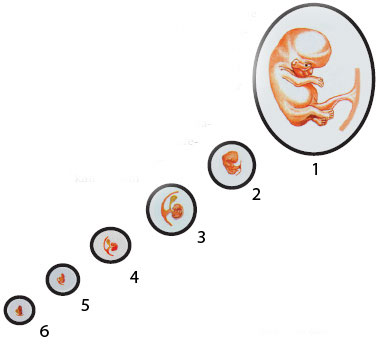 | |
| 1. 55. Day | 4. 26-27. Days |
| On the left we see the actual size of the embryo in the first days of the development of a human being. It is surely God Who causes a mass of cells that can be measured in centimetres to develop into a human being with a fully developed body. | |
In the first days the embryo takes the nourishment it needs only from the mother's blood. Now, in order to nourish its own body and send oxygen to its cells, the embryo needs its own circulatory system. So, in order to bring this system into being, a number of cells make an instant decision to cooperate, and begin to form the circulatory system. This cell activity is a clear proof that they are directed by an eternal intelligence and knowledge. On about day 13, a group of cells moves into position where the chest will be to form the heart. Arranging themselves into a U-shaped tube, with a great level of awareness they first establish the basic structure of the heart. Then, as if they had heard that the formation of the heart had begun, thousands of other cells begin to construct the blood vessels that will extend all around the body. So, with their conscious deployment to the appropriate places, the formation of the blood vessels is completed around day 21. Now, the circulatory system is ready to function, and after its first beat about day 25, the heart will maintain a rhythm of 60 beats a minute during its first month of development.39 The first contractions move throughout the whole length of the heart like a wave, but when the formation of the heart is finished, the contraction is distributed among the different chambers.
The heart begins to beat, but there is no blood yet. For this also there are the appropriate cells. These cells, in fact, calculate in advance that the newly formed human body will need a substance called "blood", and they turn into blood cells. Before long, blood starts to flow in the blood vessels. At the end of four weeks, blood begins to fill the heart and the blood vessels completely. Indeed, the formation of the heart, the circulatory system and the blood is in itself an astonishing thing. While none of these yet existed, the cells, executing a perfect plan and going to the right place at the right time, construct the circulation system indispensable for human life. None of the stages we have outlined here is the result of any chance operation; this perfect plan of construction cannot possibly be made by cells which came into being from one single cell. At this point too, what confronts us is the evident truth of creation.
| The Miraculous Formation of the Circulatory System | |
 | These cells, disposed independently of one another, are actually the cells of the blood vessels. (1-2) A little later, these cells suddenly come together and begin to form a connection among themselves. (3-4) The cells form the blood vessels. (5-6) Finally, they construct a perfect system of conduits with no cracks or perforations. The internal surface of the blood vessels is so smooth that it could have been made by hand. The total length of the blood vessels is more than 40,000 km. This is as long as the entire circumference of the earth. This magnificent design is from God, the Lord of the all the worlds.  |
Not only the formation of the circulatory system but also the characteristics possessed by every element of it are created in an astonishing balance. The blood of a baby developing in its mother's womb has many more special qualities than that of a mature individual. For example, the haemoglobin in the baby's blood is able to hold more oxygen than that of an adult. The number of red blood cells in one cubic centimetre of the blood taken from an embryo is higher than that found in the same volume of blood from a newly born baby. At fourth months, the cord can carry a circulation equivalent to 24 litres a day between the baby and its own placenta. This circulation flows in constant round trips, bringing supplies to the baby from the placenta, and returning wastes to the placenta, so swiftly that a round trip is completed in about thirty seconds.40In this way, the blood begins to take the required oxygen and nutrients from the placenta and carry them to the cells. At the moment the kidneys are formed, the blood begins to be purified by taking waste gathered from baby's cells to the kidneys.
Let us pause here to consider: Is it possible that such a perfect system could one day come into being by chance, perfectly and by itself? Is it possible that the special quality of a baby's blood, the blood vessels that carry the blood to the heart and from the heart to the appropriate areas, and the elements that bind the blood cells to the placenta came about in the course of time by chance? Is it possible that all these elements in the system constructed themselves?
| The Formation of The Heart | |
 | A. Day 23 2. Blood Vessels Coalesce The formation of the heart is an obvious wonder of creation. Suddenly, some multiplying cells begin to contract and expand. Later, hundreds of thousands of these cells come together to form the heart. This heart will continue to beat for a lifetime. On the 23rd day after fertilisation, the blood vessels of the embryo begin to coalesce; on the 25th day, only one chamber can be seen. On the 26th and 27th days the other chambers begin to develop. On the 33rd day the ventricles and the atria begin to develop and on the 40th day the heart is fully formed. In the picture of the embryo to the left, the heart is shown in red. |
 | |
 | |
It is surely not. This system, of the utmost importance for human beings, must come into being perfectly and in one moment, because any problem with the formation of the blood or the blood vessels will cause the development of the embryo to cease. If the heart pumped the blood before the formation of the blood vessels, the blood would flow uncontrolled and there would be no circulation. Or, if the heart did not begin to beat at the right time, blood would not circulate through the body. This means that the embryo would die without developing in the mother's womb. However, in every one of the millions of people who have lived throughout the ages until today, there has been no problem with these operations; the heart makes its first beat at exactly the right time and pumps just enough blood to the developing body. This makes the question we posed earlier nonsensical: "Could it have happened by chance?" The fact that a system, a living being or an organism comes into being in a moment is clear proof that it has been created. This is a plain truth that every intelligent person will affirm.
The Creator of all these perfect systems is God, Who created man together with everything he needs and gave him the best of forms.
The Construction of the Nervous System
As all these operations continue, one more important formation must take place: the central nervous system. The central nervous system (the brain and the spinal cord) arises from an elongate thickening of the ectoderm, the outermost of the three primary germ layers of the embryo. The sides of this neural plate elevate as neural folds, which, by growing further, meet and fuse, thereby creating a neural tube. The anterior part of this tube thickens and expands to form the brain; in the meantime, the posterior part forms the spinal cord.
All the developments we have summarized here in one or two sentences surpass the limits of human imagination. The other stages in the formation of the nervous system again and again confirm the extraordinary character of these developments.
From the fifth week there begins to be produced in the spinal column special nerve cells called neurons. They are produced very quickly at the rate of 5000 per second.41
A large number of brain cells are produced in the first five months of the embryo's life, and all of them will have taken their place in the brain before birth. Cells of the nervous system form very quickly and then begin to migrate to more distant areas in order to form the columns of the central nervous system.
But, at this stage, it is absolutely necessary for every neuron to find the place in the nervous system reserved for it. For this reason, a guide is indispensable in order for the young neurons to find their way. These guides are special cells which stretch out as a kind of cable between the places where the brain and spinal cord develop. The neurons leave the place where they were produced and migrate attached to these guides. They recognize the place allotted to them, lodge there and immediately send out extensions establishing connections with other neurons.
This is all very well. But how do the neurons know to set out on such a long journey as soon as they are formed? How do they decide to use a guide to reach their target and to cooperate with one another? What we call neurons are cells, too small to be seen with the naked eye, and are composed of atoms and molecules. No doubt they cannot deploy in such a conscious way by their own decision or will. What directs this activity is not the brain, because the brain of the embryo in the mother's womb has not yet developed.
As soon as these cells are formed, they move as if programmed, directed by information infused into them, to a place they do not know. It is clear that in the process of the formation of the brain and the nervous system, no occurrence can come about by chance, because a variation in one single stage would cause a chain reaction making the whole system go wrong. The formation of neurons and their becoming a system of nerves is only one stage in the formation of the brain and the nervous system attached to it. Let alone the brain, as the evolutionists claim, not even one neuron can be formed by coincidence.
 |  |
| The construction of the brain appears clearly in the watery environment of the mother's womb. This construction is accomplished by cells which have no intelligence or awareness. At the end of this wondrous process the baby will have a total of 10 billion brain cells. Every cell acts with prior knowledge of what cells it must connect with. From among endless possibilities, it finds the place where it belongs. It unites with the cell that it must unite with. In the end, it will have made 100 trillion perfect connections in the brain. That will which allows unconscious cells, working in the dark, to construct the world's most excellent computer—the brain—is the eternal knowledge of God. | |
| O man! What has deluded you in respect of your Noble Lord Who created you and gave you an upright form and proportioned you? In whatever shape He willed, has He moulded you. | |
There are many more details of this development. For example, when they first come to be, the neurons have a different structure from those of a mature human being. In order to perform the functions required by the nervous system of a developing human being, the neurons migrate to a particular part of the body, and in the first stage, their metabolism enables them to survive without oxygen. However, when they arrive at the brain area and establish themselves there, they immediately acquire a metabolism that depends on oxygen for its survival. For the benefit of all the nerve cells this transformation must take place perfectly every time, otherwise their survival would not be possible. This is no doubt a miraculous thing.42
We know today that it is highly dangerous for human brain cells to remain without oxygen for a certain period, and if that period be prolonged, first paralysis, then death are inevitable. But the neurons which first come into being have a totally different system. If there is a problem at this stage only, that is, if there is no change in the metabolism of the neurons at exactly the right moment, the embryo will not develop into a human being. Of course, it is not possible for a cell to determine what function it will perform in the future and to change its structure by its own will and conscious awareness in order to perform this function.
This being the case, we are confronted by a clear truth: it is God Who creates the neurons with these characteristics, puts them to work at the right moment and places them where they must go. Every human being should know that he has been brought through these stages, and give thanks when he sees the magnificence with which God has created him as a human being. He must not for one moment forget that God is the Creator of everything, and that apart from Him, there is no other power on heaven or on earth.
... Do you then disbelieve in Him Who created you from dust, then from a drop of sperm, and then formed you as a man? He is, however, God, my Lord, and I will not associate anyone with my Lord. (Qur'an, 18: 37-38)
The Importance of "Planning" Among the Cells
When we look at the development of the embryo, we see that it shows a high degree of proportion and harmony. At the end of the first month, fully developed eyes, ears, nose, chin and cheeks become visible.
O man! What has deluded you in respect of your Noble Lord Who created you and gave you an upright form and proportioned you? In whatever shape He willed, has He moulded you. (Qur'an, 82: 6-8)
In the course of this harmonious development it is very important that growth and structural change are ensured. It is necessary that these changes occur in the same way for all parts of the body, because all the organs of the human body have a highly complex structure. For example, the eye alone has 40 different parts. In order for the eye to be able to perform its function, it is necessary that the growth of these parts be proportionate, the connections between the parts be sound and that every part be in its own place. Otherwise, the eye could not perform its function. In the same way, in the formation of the arm, the bones and muscles must begin their formation at the same time.
As can be understood from this, all the cells of the embryo act in harmony. Every one of them is aware of the general plan of the body. Every one of them sends a number of messages and reacts to messages coming from other cells. All the cells in the embryo act together; with real understanding, each one different from the other, they use what is required in the information contained in the DNA as needed.
| It is God Who Creates the Body From a Piece of Flesh | ||
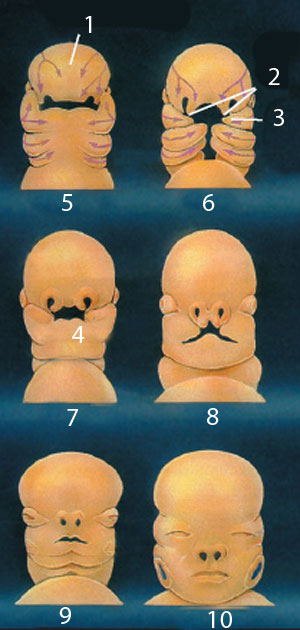 | 1. Embryo’s forehead begins to form 5. Day 28 Before it begins to develop, the embryo resembles a mass of flesh. The eyes, ears, heart and other organs develop and a brand new person comes into being. Above we can see the series of developments that occur in the formation of the human face. Every human being on the face of the earth has undergone these stages. As a collection of cells unaware of its own existence, a human being continues through this development in a protected and secure environment prepared in the mother's womb. The symmetrical eyes, the eyebrows, nose, mouth, and the protective skin are all formed in the mother's body. These wondrous transformations seen in the picture above are a proof of the creative art of God. It is the duty of every person in the world to consider this truth and give thanks to God. | 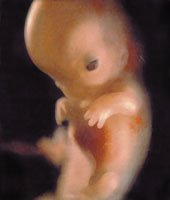 |
 | ||
 | ||
But how do the cells know where to go and what to do? How can they act in such harmony together with other cells? Who decides how to use the genetic material contained in the cells and how will the cells differentiate between one and another?
In the organs of our bodies there must be no deficiency or excess. A deficiency in an organ is sometimes fatal; at least it causes some disability. An excess places an unnecessary burden on the body. In that case, first it is necessary to determine the number of organs that the body needs. How is this number determined? How is it that when a group of cells begins to make an organ, another group of cells is not making a second, exactly similar organ?
Evolutionists try to avoid this issue by saying that the DNA molecule is responsible for all these functions, but this is only a deception. The basic point to consider here is this: who placed all the information in the DNA molecule of every cell of the body? Moreover, who decided where, when and how this information is to be used? To these questions the evolutionists can give no answer.
Cells formed from unconscious and lifeless atoms, blood vessels, tissues, air, wind, or any other material thing, have no power to make such a decision. It is God Who imprinted this marvellous plan in the DNA and it is God Who ensures the perfect realization of this plan by inspiring the cells to do what they must. God has power over all things.
| The Marvellous Creation of the Eye | |||||||||
| Here we must ask ourselves a few questions: How do these cells know that they must construct different layers? How do they decide where to begin and end the construction of each layer? To these questions there is only one answer: The cells are able to perform this conscious activity because they move under the inspiration of God. But evolutionists who try to explain the formation of a human being by the operations of chance cannot give an answer to these questions.
One evolutionist who explained the perfect plan in the human body was Hoimar von Ditfurth. In his book, Im Anfang War Der Wasserstoff (In the Beginning was Hydrogen), he explained the formation of a human being in detail, but he confessed that the theory of evolution could never give an answer to the questions "how" or "why":
| |||||||||
| In the formation of the eye, "the world's finest camera", we have seen that unconscious cells act with the utmost awareness, creating the eye in the mother's body from nothing. Certainly, it is not the cells themselves that succeed in doing this extraordinary thing: they act under the inspiration of the Almighty God. In the Qur'an, God reveals that He gives human beings their form: He is God—the Creator, the Maker, the Giver of Form. To Him belong the Most Beautiful Names. Everything in the heavens and earth glorifies Him. He is the Almighty, the All-Wise. (Qur'an, 59: 24) |  | ||||||||
| |||||||||
| The Wrapping of Muscles Over the Bones | ||||||||
| Until very recently, embryologists assumed that the bones and muscles in an embryo developed at the same time. Yet, recent research has revealed a very different fact which had gone unrecognised by man. First, the cartilage tissue of the embryo ossifies. Then muscular cells that are selected from amongst the tissue around the bones come together and wrap around the bones. This fact, which has recently been discovered by science, was related to man in the Qur'an 1,400 years ago:
This event, of which the Qur'an informed us 1,400 years ago, is thus described in a scientific publication titled Developing Human:
In short, man's developmental stages as described in the Qur'an are in perfect harmony with the findings of modern embryology. God, the Lord of all the worlds, had given this information to man centuries ago. | ||||||||
Preparations for the World Outside
The baby, whose organs are slowly developing and who is beginning to move, awaits a further development. In order for the baby to survive in an environment totally different from the secure one in which it now lives, it is necessary that the required arrangements be made.
To this end, the baby needs to start moving slowly and put its newly formed organs into operation. This problem has been solved in the most wonderful way. In the membrane separating the baby from the uterus, a special fluid called "amniotic fluid" begins to be produced. The baby's kidneys and lungs, the amniotic membrane and the surrounding uterus contribute to the formation of this fluid.45
The Baby's "Water of Life": Amniotic Fluid
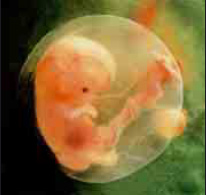 |
| At the right, the foetus can be seen in the amniotic membrane. The fluid inside the membrane protects the foetus from shocks and trauma. In addition, the amniotic fluid also prepares the intestines of the foetus for their absorptive function, assists the functioning of the kidneys and ensures the constant temperature needed by the foetus. The presence of amniotic fluid is also important for the health of the mother. Because of this fluid, the foetus is prevented from exerting pressure on the uterus. |
Amniotic fluid is specially produced for the baby; it ensures that the organs are prepared to function after birth. The baby, as it were, practises with the amniotic fluid to become accustomed to the outside world by regularly ingesting it. In this way, its tongue begins to perceive bitter, sweet, salty and sour tastes. Afterward, the saliva glands begin to function. The amniotic fluid ingested by the foetus begins to prepare the intestines for their absorptive function, and it makes the kidneys function by creating the necessity for the constant filtration of this same fluid from the blood. The fluid absorbed from the kidneys is transmitted back again to the amniotic fluid, without contaminating it, because the kidneys have the ability, distinct from their later function, to filter and sterilize the fluid ingested by the baby. And this fluid, as when you clean a swimming pool, is continually purified with the help of a few other fluids.
In the same period along with these developments, digestive fluids begin to be secreted in the stomach in order that the digestive system may be fully prepared.46And the cells in the baby's newly formed intestines acquire the ability to distinguish between sugars and salts and later to return particular waste products to the mother's blood. In this way, both the intestines and the kidneys are put into action. The amniotic fluid is ingested by the intestines of the foetus once every three hours, that is, eight times a day and is returned to the mother via the blood. As much fluid as is ingested is released to the pool of amniotic fluid both from the mother's womb and from the lungs and kidneys of the foetus where it is produced. In this way, the amount of this fluid, so vitally important for the foetus, remains constant. Because of this perfect system, the digestive system of the foetus is put into operation without any harm to the foetus.
 | |
| 1. Yolk sac of embryo | 4. Amniotic cavity |
| The greatest factor in the preparation of the baby for the outside world is without doubt amniotic fluid. | |
Synchronized with the growth of the foetus, the amount of amniotic fluid increases, reaching about 30 ml at ten weeks, 350 ml at five months, and 1 litre by the seventh month. At the moment of birth however, the amount of fluid falls to half a litre.47
The amniotic fluid not only prepares the digestive system for the post-birth period, but also ensures that the baby may move more comfortably in the mother's womb. The foetus floats in this fluid like a rowboat tied up in a harbour. In this state it can move very securely in the mother's womb. At the same time, this fluid protects the foetus from any physical trauma from outside. Pressure applied on the fluid from any direction is dispersed equally in every direction protecting the foetus from any harmful effects. For example, if the mother runs, the jolts produced have no effect on the baby; it is like a cork shaken in a container filled with water. The most perfect protective system possible has been created for the foetus; every kind of danger has been foreseen and precautions taken.
The presence of amniotic fluid is also important for the health of the mother. This fluid fills the whole womb, so as the foetus grows and gains weight, no pressure is exerted on the womb itself. If this fluid were not present, the growing foetus would weigh the uterus down and the counter-pressure exerted by the uterine walls would make the normal development of the foetus impossible.
 |
| Without amniotic fluid it is not possible for a baby to develop in the mother's uterus. This fluid has been produced flawlessly from the time of the first human being until today. This invalidates the claim of the evolutionists that this development occurred by changes which happened stage by stage over a period of time. |
This special fluid provides another vital necessity for the foetus: a constant temperature. It is known that fluids distribute heat evenly. The amniotic fluid is recycled continually and has a constant temperature. The heat needed for the development of the foetus is distributed equally in every direction.
If there is a single problem with the production of this fluid, with its continuous purification or the adjustment of its volume, the natural development of the foetus is impaired. For example, if the amount of amniotic fluid is less than required, or if it is not present at all, a series of abnormalities begins to appear. Limbs wither and become deformed, joints fuse, skin loosens and, because of pressure, the face is deformed. The most serious problem is that the development of the lungs is impeded and the baby dies immediately after birt.48
All this shows us that from the first human being until now, the production of amniotic fluid has continued flawlessly. Without it, a baby could not develop in its mother's womb. This fact completely discredits the evolutionists' claim that development occurs stage by stage over a period of time. If one single stage in the creation of a new human being did not occur, for example, as we said just now, if the production of amniotic fluid were deficient, birth could never take place and the human race would never have come into existence. Therefore, it cannot be claimed that amniotic fluid began to be produced over a period of time when the need for it arose. This fluid must exist along with the baby. It is impossible to claim that such a fluid, which has such important functions, was formed in a moment by chance. To say that a complex organism came to exist in a moment is to say that this organism was created. It is impossible for chance actions to calculate, determine needs, to select the things appropriate for these needs and apply them at the right time and in the right place.
It is clear that God creates the amniotic fluid and the systems to which it is connected. He too determines the amount of amniotic fluid required.
God knows what every female bears and every shrinking of the womb and every swelling. Everything has its measure with Him. (Qur'an, 13: 8)
| Special Tiny Hairs Protecting the Baby | |
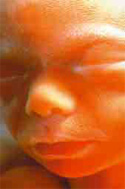 | The baby developing in the mother's womb is protected by the amniotic fluid. But if the baby spends too much time in this fluid, it will suffer damage. But this does not happen. The baby's body has an excellent defence against damage by this fluid. In the fifth month, tiny colourless hairs cover the baby's body. These hairs remain on the baby's body for three or four months. Before birth they cover the baby's body almost completely. Because of these hairs, the amniotic fluid will not be able to damage the baby's skin. It it clear that the presence of these hairs is a special precaution taken to protect the baby. In the development of the baby in the mother's womb there is no deficiency in any detail. This system is organized so that no problems will occur and it is only one of the manifestations of the limitless creative power of God. |
Preparations for the First Breath
After birth the most important thing for the baby is to breathe; it is necessary that the lungs, which had never known air before, fill with it and start to breathe. The baby, who had previously received oxygen from the mother's blood, must now take it from the air with his own lungs. And in a miraculous way, the lungs, when had never taken a breath before the first moment of birth, begin to breathe quite normally.
At the moment the baby is born, God creates everything in readiness and ensures that the preparation of the lungs has been completed as required. For the preparation of the lungs, the diaphragm comes into play; it is located between the stomach and the rib cage. The diaphragm begins to function towards the sixth month of pregnancy. At first it expands and contracts intermittently several times an hour, but after birth it will do this continuously.
It can be seen from this that the baby is constantly under special protection, but it must be remembered that this is not the mother's protection. As the foetus develops, the mother carries on her normal life; none of the changes in her body are under her control. Even if she wanted to intervene, she could not. All these developments occur by the eternal power of our Lord. God has created all the things required for a child to come into the world as a normal human being in the most wonderful way. All the needs of the baby while it is in the foetus stage are met, and the mother is spared the necessity of thinking about what she must do to bring the baby into the world and ensure that the baby will survive.
Even if she thought about doing something to this end, there is nothing she could do. For example, taking waste material from the body of the foetus into her own kidneys, purifying it and discharging it are things which no mother could do on her own. It is God Who determines all the needs for a new human being to come into the world and constructs the system in the way that will best respond to these needs.
The Preparations are Completed
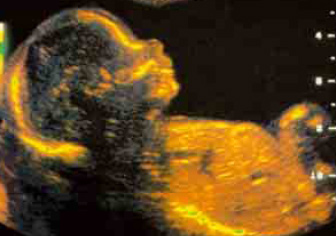 |
| It is possible with today's technology to observe the development of the baby in the mother's womb with ultrasound. |
As the foetus gradually gets prepared for life in the outside world, an extraordinary team of workers is organized among the organs. The work that will be done is determined according to the conditions in the outside world. The eyes, unused in the mother's womb, are constructed for the intensity of the world's light; the ears are made for the world's sounds. In the same way, the stomach and the other digestive organs are equipped with a physiological system designed to function in relation to this world's nutrient material. The cells of the digestive system are programmed and adjusted so as to digest food they have never encountered. Along with their ability to analyse carbohydrates and fats, they are programmed to know which nutrients are required by which organs and to ensure that these nutrients are sent to the relevant cells in the body. So, the foetus is prepared for the outside world in a planned and programmed way. Here we must point out again that these organs and cells that constitute the body of a new human being make these preparations for an environment that they have never seen, heard of or otherwise experienced. They develop as if they were aware of the environment that was waiting for them after leaving the mother's body. Certainly it is impossible to claim that these cells accomplish these acts by their own prescience. The conscious and deliberate preparations made by the cells in forming a baby's body, inspired in them by God, must be considered as an important proof of creation.
In the final months, the foetus begins to gain weight. Certain cells produce a fat layer which is named "brown fat" because it has a brownish colour. The special brown fat develops in particular areas of the foetus such as the nape of the neck, around the kidneys and behind breastbone. In addition to providing insulation, brown fat itself produces heat. The special function of this fat layer is to keep the baby warm in the early weeks after birth.49The fact that these cells which produce this fat layer flawlessly perform the duties that have been inspired in them is another proof of creation.
In the meantime, the skin of the foetus undergoes important changes resulting in the development before birth of skin surface which is critical for survival after birth. The skin of the foetus produces an oily surface covering which confers a water repelling property to the surface of the skin in contact with the amniotic fluid. This oily surface layer has an important effect to promote maturation of the underlying skin cells and the formation of a skin barrier before birth
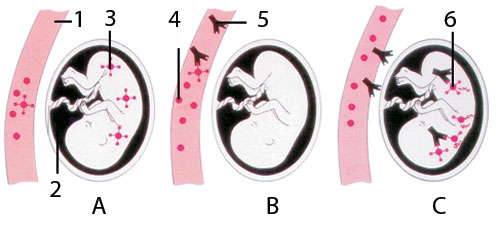 | 1. Mother’s Blood Vessel 3. Rh (+) int the baby The placenta protects the baby from the mother's immune cells right up until the ninth month. |
| A. Very little Rh (+) erythrocyte is carried into the mother's blood from the foetus by means of the placenta | |
In earlier sections, we mentioned that in the early stages of the embryo, the mother's defensive cells are not permitted access to the baby's blood. These cells see the baby as a foreign intrusion and could kill it. But in the ninth month, this situation changes suddenly and antibodies (a protective protein produced by the immune system) in the mother's womb pass to the foetus through the placenta. When we examine the reason for this, we are struck by something very surprising. In the first six months after birth, the cells in the baby's immune system do not develop, but the baby will need antibodies to protect it from the germs in the world. So, in the last month, the mother's antibodies, which are permitted access to the baby's blood, will be ready to protect the baby from contracting infectious diseases when it is first born.50In the subsequent months, as the baby's immune system begins to produce its own antibodies, the mother's antibodies will cease functioning.
As in what we have said before, this operation too, as outlined above, is an example of the perfect plan in the creation of human beings. The details in every month, every day, every minute of the formation of a human being are minutely calculated. Flawless systems prevent harmful material from reaching the foetus, but when these materials are needed, the old system is removed according to the same perfect plan, and a new one is put in place. Certainly, this perfection does not come about by the deliberate decision and will of the cells which make up a human being. All these things are proof of the incomparable creation of Almighty God.
|
1. Maternal antigen |  |
| One of the functions of the placenta is to protect the baby from the mother's defensive cells (top). But this protection continues only up to a certain month. In the ninth month, this situation changes and the antibodies in the mother's body pass with the help of the placenta into the foetus (large picture). For the first six months of life in the world, the baby's immune cells will not be formed. This would mean death for the baby. Therefore, it is very important that the placenta gives permission for the antibodies to pass. It is clear to everyone that the cells comprising the placenta are by themselves incapable of such conscious behaviour. It is God Who creates these cells and inspires them as to what they must do. | |
As can be seen in the examples given, every stage in the development of a human being is controlled and occurs according to a perfectly ordered plan. And every human being, while in the foetus stage, undergoes this controlled development and grows into maturity. The special plan and perfect design in the development of a human being is a manifestation for aware individuals of the eternal knowledge and wisdom of God.
Creation from a Drop
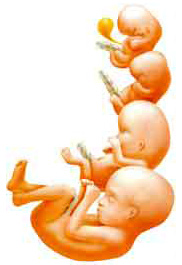 During the nine months in the mother's womb, growth continues perfectly. The foetus first enters the womb as a drop of fluid and gradually turns into a human being.
During the nine months in the mother's womb, growth continues perfectly. The foetus first enters the womb as a drop of fluid and gradually turns into a human being.
If there were the slightest lack of coordination in this development, the foetus would surely die. For example, if the brain grew more quickly than the bones of the skull, the brain of the foetus would be compressed and suffer damage. This coordination is also important for the formation of the eyes, the liver and heart, as well as other organs and the bones which surround them. The ordered development of the organs is also very important because, if the kidneys were slow to develop and the circulatory system had already formed, the blood would not be purified and the body would be poisoned.
But this does not happen and the baby about to open his eyes to the world is created by passing perfectly from one stage to another.
The only power that creates a complete human being from what was at first just a drop of fluid is that of Almighty God, the Lord of the universe.
The Qur'an tells how God created human beings:
Does man reckon he will be left to go on unchecked? Was he not a drop of ejaculated sperm, then an alaq (embryo) which He created and shaped, making from it both sexes, male and female? Is He Who does this not able to bring the dead to life?(Qur'an, 75: 36-40)
Certainly, an individual confronted by this truth will always be thankful to his Lord for creating him from a drop of fluid and making him a seeing, hearing and thinking person.
Say: "It is He Who brought you into being and gave you hearing, sight and hearts. What little thanks you show!" (Qur'an, 67: 23)
Footnotes
21 Gerard J. Tortora, Introduction to the Human Body The Essentials of Anatomy and Physiology, Biological Science Textbooks, 1997, s. 569-570
22 Solomon, Berg, Martin, Villee, Biology, Saunders College Publishing, ABD, 1993, s. 1066
23 Geraldine Lux Flanagan, Beginning Life, A Dorling Kindersley Book, Londra, 1996, s. 28
24 Guyton&Hall, Tıbbi Fizyoloji, Nobel Tıp Kitabevleri, İstanbul, 1996, 9. baskı, s. 1034
25 Guyton&Hall, Tıbbi Fizyoloji, Nobel Tıp Kitabevleri, İstanbul, 1996, 9. baskı, s. 1039
26 Geraldine Lux Flanagan, Beginning Life, A Dorling Kindersley Book, Londra, 1996, s. 33
27 . Gerard J. Tortora, Introduction to the Human Body The Essentials of Anatomy and Physiology, Biological Science Textbooks, 1997, s. 556
28 . Geraldine Lux Flanagan, Beginning Life, A Dorling Kindersley Book, Londra, 1996, s. 38
29 Science et Vie, Mart 1995, sayı: 190, s. 48-50
30 Hoimar Von Ditfurth, Dinozarların Sessiz Gecesi 2, Alan Yayıncılık, 1997, s.126
31 Geraldine Lux Flanagan, Beginning Life, A Dorling Kindersley Book, Londra, 1996, s. 42
32 Geraldine Lux Flanagan, Beginning Life, A Dorling Kindersley Book, Londra, 1996, s. 42-43
33 Richard Dawkins, The Selfish Gene, Oxford University Press, New York, 1976, s. 37
34 Geraldine Lux Flanagan, Beginning Life, A Dorling Kindersley Book, Londra, 1996, s. 34
35 Science et Vie, Mart 1995, sayı: 190, s. 48-50
36 Intimate Universe, The Human Body, Volume 1, 1998 British Broadcasting Corporation
37 Guyton&Hall, Tıbbi Fizyoloji, Nobel Tıp Kitabevleri, İstanbul, 1996, 9. baskı, s. 1035
38 Science et Vie, Mart 1995, sayı: 190, s. 48-50
39 Solomon, Berg, Martin, Villee, Biology, Saunders College Publishing, ABD, 1993, s. 1069
40 Geraldine Lux Flanagan, Beginning Life, A Dorling Kindersley Book, Londra, 1996, s. 73
41 Science Vie, Mart 1995, sayı: 190, s. 88
42 Science et Vie, Mart 1995, sayı: 190, s. 48-50
43 Hoimar Von Ditfurth, Dinozarların Sessiz Gecesi 2, Alan Yayıncılık, 1997, s.129-130
44 Keith L. Moore, The Developing Human - Clinically Oriented Embryology, W. B. Saunders Company, 1983, Canada, s. 374a
45 Geraldine Lux Flanagan, Beginning Life, A Dorling Kindersley Book, Londra, 1996, s. 74
46 Geraldine Lux Flanagan, Beginning Life, A Dorling Kindersley Book, Londra, 1996, s. 64
47 Keith L. Moore, The Developing Human - Clinically Oriented Embryology, W. B. Saunders Company, 1983, Canada, s. 126
48 Science et Vie, Mart 1995, sayı: 190, s. 48-50
49 Geraldine Lux Flanagan, Beginning Life, A Dorling Kindersley Book, Londra, 1996, s. 87
50 Laurence Pernoud, J’attends un enfant, Pierre Horay, Paris, 1995, s.135

 In the fourth week, two cavities are formed on either side of the embryo's head. It is hard to believe, but the eyes will be formed in these cavities beginning in the sixth week. For months the cells work according to an incredible plan, forming the various parts of the eye one by one. Some cells make the cornea, some make the pupil and others make the lens. When a part that a particular cell constructs is completed, the cell ceases to work. Each cell makes a different part of the eye; afterwards, they unite with one another in a marvellous way. There is no error in the process; nothing else takes the place of the pupil, and the cornea, eye muscles, and every other element is in place. These operations continue and the eye is perfectly formed with its various layers.
In the fourth week, two cavities are formed on either side of the embryo's head. It is hard to believe, but the eyes will be formed in these cavities beginning in the sixth week. For months the cells work according to an incredible plan, forming the various parts of the eye one by one. Some cells make the cornea, some make the pupil and others make the lens. When a part that a particular cell constructs is completed, the cell ceases to work. Each cell makes a different part of the eye; afterwards, they unite with one another in a marvellous way. There is no error in the process; nothing else takes the place of the pupil, and the cornea, eye muscles, and every other element is in place. These operations continue and the eye is perfectly formed with its various layers.



